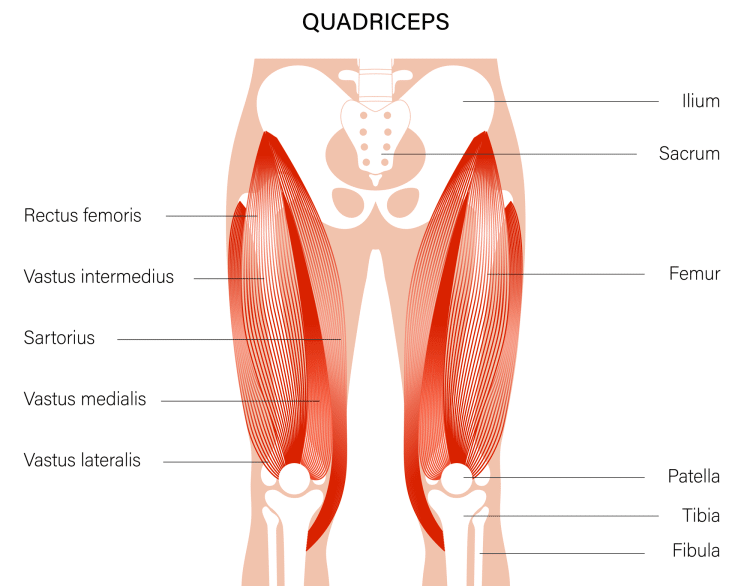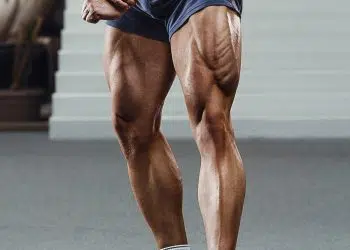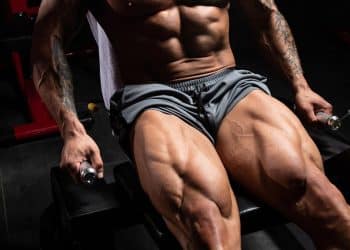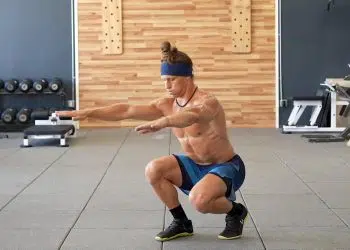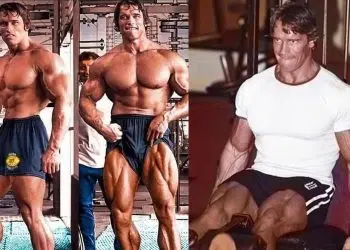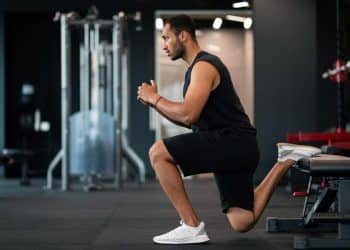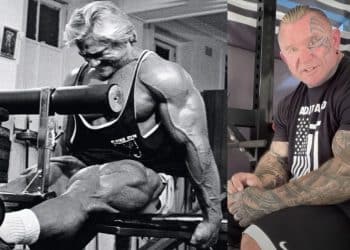The leg extension is a popular exercise and arguably the most effective way to isolate your quads. All that said, doing set after set of regular leg extensions can soon become boring. After all, you don’t just do bench presses for your chest or barbell curls for your arms. Instead, you use a variety of exercises to maximize growth and engage your brain as much as your muscles.
Thankfully, there is more than one way to do leg extensions, each one more intense (and painful!) than the last.
So, breathe new life into your quad-building workouts with the seven best ways to use a leg extension machine!
Leg Extensions – Muscles Worked
Leg extensions are an isolation exercise. Contrary to what many people think, this doesn’t mean they isolate one muscle. Instead, isolation exercises involve movement of a single joint and often work several muscles.
In the case of leg extensions, the muscles worked are the quadriceps, which are actually several muscles that work together. Usually described as a group of four muscles, there are actually six quads, although two are usually overlooked:
Level Up Your Fitness: Join our 💪 strong community in Fitness Volt Newsletter. Get daily inspiration, expert-backed workouts, nutrition tips, the latest in strength sports, and the support you need to reach your goals. Subscribe for free!
Rectus Femoris
The rectus femoris is a biaxial muscle that crosses the knee and hip, affecting both joints. Its functions are knee extension and hip flexion. It originates (starts) from the ilium bone of the pelvis and inserts (ends) at the patella (kneecap) and tibial tuberosity, which is the bump at the top of your shin bone.
Vastus Lateralis
The vastus lateralis is the largest muscle in the quadriceps group. It’s located on the lateral aspect or outside of the thigh and originates on the femur and inserts into the patella and tibial tuberosity. Its function is knee extension.
Vastus Intermedius
Located between the vastus lateralis and vastus medialis, the vastus intermedius originates on the front and side of the femur and inserts into the patella and tibial tuberosity. Like the other quad muscles, its function is knee extension.
Vastus Medialis
The vastus medialis is located on the inside of the thigh, just above the knee. It originates on the femur and inserts into the patella and tibial tuberosity. Its function is knee extension, and it’s especially active during the last few degrees of movement. The vastus medialis also plays an important role in controlling the alignment and motion of your kneecap.
Tensor vastus intermedius
This relatively new muscle was only discovered in 2016 (1). Located between the vastus lateralis and vastus intermedius, the tensor vastus intermedius is another often overlooked quadriceps muscle. It originates on the pelvis and inserts onto the medial aspect of the patella, making it a relatively long muscle. However, the bulk of the tensor vastus intermedius is at its proximal end, and it’s actually more tendon than muscle tissue.
Articularis genus
The Articularis genus is a small muscle within the quadriceps group. It originates low on the femur and inserts onto the upper part of the patella bursa, which is a fluid sack that reduces friction between a tendon and bone. While this IS a small muscle, it plays a crucial role in the efficient movement of the knee joint.
How to Do Leg Extensions
Before we get into some new ways to use a leg extension, let’s make sure you’re doing the basic version of this exercise correctly. After all, incorrect form now will probably mean that you will do the variations incorrectly, too.
- Adjust the backrest of the machine so that, when you sit on it, your knees align with the lever arm pivot point.
- Adjust the leg pad so it rests on your ankles and doesn’t move as you extend your legs. If the pad rolls up and down, it is not in the correct place.
- Sit on the machine with your knees back against the edge of the seat. Grip the handles at your sides.
- Without kicking or jerking, smoothly extend your legs until they are straight.
- Bend your legs and lower the weight back down.
- Continue for the desired number of reps.
Pro Tips:
- Pause for a second with your knees straight to maximize quadriceps engagement.
- Avoid letting the weights touch together to keep your muscles under constant tension.
- Use your arms to pull your butt down and back into the seat when using heavy weights.
- Pull your toes up toward your shins to increase quadriceps activation.
- Perform this exercise smoothly and deliberately for best results.
Leg Extension Benefits and Drawbacks
Not sure if leg extensions deserve a place in your workouts? Consider these benefits and then decide!
A very safe exercise
Injuries with leg extensions are very rare. They put no stress on your lower back and are relatively knee-friendly, provided you don’t go too heavy or use poor technique. They’re also ideal for training to failure, as you can just return to the starting position when you are unable to continue. There is no danger of getting pinned under a heavy weight.
One of the only ways to isolate your quads
Most leg exercises involve the knees and hips working together. This means that, as well as your quads, you’ll also be working your glutes and hamstrings, abductors and adductors. While this is not necessarily a bad thing, it does mean your quads may be overshadowed by these other muscles. Leg extensions allow you to prioritize your quads.
Easy to perform
Leg extensions are a very straightforward exercise. They’re easy to learn, which makes them ideal for beginners. However, more experienced exercisers will also appreciate this simplicity as, with no tricky movements to coordinate, they are free to focus on pushing their muscles to their limit.
Ideal for muscle building, pump-inducing drop sets
Most leg extensions have selectorized weight stacks so you can quickly change the weights without getting off the machine. This feature makes leg extensions perfect for drop sets. Rep out to failure as usual, but when you hit failure, reduce (or drop) the weight by 10-15% and rep out again. Perform 2-4 drops to fry your quads. And yes, that intense, deep burn is entirely normal!
Great for pre- and post-exhaust training
Pre-exhaust training involves doing an isolation exercise before a compound movement for the same muscle group, e.g., leg extensions before squats. Needless to say, this makes the second exercise much more challenging.
In contrast, post-exhaust training involves doing a compound exercise followed by an isolation movement for the same muscle, e.g., leg press followed by leg extensions. This allows you to wring out a few more reps and push your muscles past their usual limits.
Both pre- and post-exhaust are great ways to increase the intensity of your workouts and could help trigger greater hypertrophy or muscle growth.
Read more about pre- and post-exhaust training here.
A great way to increase your quadriceps mind-muscle connection
You cannot expect to build a muscle you cannot control or feel working. A lot of lifters complain that they don’t really feel their quads during squats and leg presses despite the exercises being challenging. Doing leg extensions teaches you to reconnect your mind with your muscles for more effective workouts. Bodybuilders call this the mind-muscle connection.
Good for knee stability
Strengthening the quadriceps, especially the vastus medialis, can help improve knee stability. Lateral movement of the knee joint can cause wear and tear, potentially leading to injuries. Stronger quads result in increased knee stability and fewer unwanted movements. Leg extensions are frequently used during early and mid-stage knee injury rehabilitation, e.g., post-surgery.
While leg extensions are a mostly beneficial exercise, there are also a few drawbacks to consider:
Knee joint shearing force
While leg extensions are generally quite joint-friendly, they’re not 100% safe. The relationship between your knees, the seat, and the position of the load puts a significant amount of shearing force through the joints. This means that while your femur remains stationary, your tibia or shin bone is pushed backward.
Shearing force is not really a problem unless you have damaged anterior or posterior cruciate ligaments. So, skip this exercise and its variations if you have a history of ACL and especially PCL injuries.
Easy to cheat
Watch a lot of people doing leg extensions, and you’d be forgiven for thinking they were playing soccer! They kick the weight up so that, mid-rep, there is very little tension on the target muscles. Using too much weight is the most common cause of this technique fault. So, go lighter and lift the weight smoothly to make your workout both safer and more effective.
Not very functional
A functional exercise is one that prepares you for the challenges of life outside the gym, such as everyday activities or sports. Examples include push-ups, lunges, Romanian and conventional deadlifts, and squat jumps. Invariably, functional exercises involve multiple muscles and joints working together combined with a load that can move in various directions.
Leg extensions are not very functional. They’re performed seated, the weight and your movements are is guided, and they don’t replicate any natural activities. They’re a good exercise for building bigger quads, but they probably won’t do much for your athletic performance or functional fitness.
Can be repetitive and boring
Set after set of the same old leg extensions can soon become boring. The good news is that, in the next section of this article, we’re going to share some new ways to do leg extensions and make this exercise fun again. By fun, we obviously mean more intense and effective!
Level Up Your Fitness: Join our 💪 strong community in Fitness Volt Newsletter. Get daily inspiration, expert-backed workouts, nutrition tips, the latest in strength sports, and the support you need to reach your goals. Subscribe for free!
Related: Best Leg Extension Alternatives for Quads Size and Strength
7 Best Ways to Use a Leg Extension Machine
Are you bored of doing regular leg extensions? Do they no longer provide you with much of a challenge? Liven up your quads workouts with these new and unusual variations!
1. Single-leg leg extensions
Muscles targeted: Quadriceps.
Most people have one leg stronger than the other. While a slight strength imbalance is normal and nothing to worry about, more significant differentials can be a problem and could lead to injuries. If nothing else, you might have one leg bigger than the other. Training one leg at a time is the best way to fix these issues.
Use your weaker/smaller leg first, then match your performance with your stronger leg. Gradually, your weaker leg will catch up with your stronger one.
Steps:
- Adjust the backrest of the machine so that, when you sit on it, your knees align with the lever arm pivot point. Adjust the leg pad so it rests on your ankle and doesn’t move as you extend your leg.
- Sit on the machine with your knees back against the edge of the seat. Grip the handles at your sides.
- Without kicking or jerking, smoothly extend one leg until your knee is straight.
- Bend your leg and lower the weight back down.
- Continue for the desired number of reps.
- Switch sides and repeat.
Benefits:
- Fix your left-to-right strength imbalances.
- You will probably be stronger using one leg at a time than both legs.
- Suitable for forced reps, drop sets, and other intensifying methods.
Tips:
- You can also do this exercise with an alternating leg action.
- Use your non-working leg toward the end of your set to push out a couple of forced reps.
- Take care not to kick the weight up.
2. 2:1 accentuated eccentric leg extension
Muscles targeted: Quadriceps.
You are stronger eccentrically than you are concentrically. This means you can lower more weight than you can lift. You probably won’t be able to find a spotter to help you lift a heavy weight so you can lower it yourself, so use this method to overload your quads and promote renewed muscle growth.
Steps:
- Adjust the backrest of the machine so that your knees align with the lever arm pivot point. Adjust the leg pad so it rests on your ankles and doesn’t move as you extend your legs.
- Sit on the machine with your knees against the edge of the seat. Grip the handles at your sides.
- Without kicking or jerking, raise the weight with both legs but then lower it slowly with one. Really accentuate that eccentric/negative movement.
- Raise the weight again with both legs and then lower with the other.
- Continue alternating legs for the desired number of reps.
Benefits:
- An effective way to expose your muscles to more weight than usual.
- An ideal workout method for solo trainers.
- Eccentric contractions are strongly linked to increases in muscle size.
Tips:
- Use about 60% of your usual leg extension training weight.
- The slower you lower the weight, the more challenging and effective this exercise becomes.
- You can also do all your reps on one leg before switching sides.
3. 1 ½-rep leg extensions
Muscles targeted: Quadriceps.
If you want to develop your vastus medialis or tear-drop quad, this is the exercise for you. Each rep involves one full rep and one top-range half rep to really fry your vastus medialis and force it to grow. Be warned; off all the ways to do leg extensions, this could be one of the most painful!
Steps:
- Adjust the backrest of the machine so that your knees align with the lever arm pivot point. Adjust the leg pad so it rests on your ankles and doesn’t move as you extend your legs.
- Sit on the machine with your knees against the edge of the seat. Grip the handles at your sides.
- Without kicking or jerking, raise the weight with both legs and then pause briefly.
- Next, bend your legs and lower the weight halfway down.
- Extend your legs once more, and then lower the weight all the way down.
- That’s one rep – keep going!
Benefits:
- Increases time under tension for a more effective workout.
- One of the best ways to target the vastus medialis or tear drop quad.
- Produces an intense burn and deep pump in the quadriceps muscles.
Tips:
- Don’t go too heavy; this is a very challenging exercise.
- Avoid kicking the weight up. Instead, move smoothly and deliberately.
- Don’t let the weights touch down between reps.
4. Isometric leg extension holds
Muscles targeted: Quadriceps.
Of the three types of muscle contraction (concentric/lifting, eccentric/lowering, isometric/static), eccentric contractions are the strongest. This means you can generate more force while stationary than you can while moving. This exercise exposes your muscles to much heavier loads than you could lift or lower. On the downside, you may need a training partner to help you raise the weight into the correct starting position.
Steps:
- Adjust the backrest of the machine so that your knees align with the lever arm pivot point. Adjust the leg pad so it rests on your ankles and doesn’t move as you extend your legs.
- Sit on the machine with your knees against the edge of the seat. Grip the handles at your sides.
- Raise the weight until your legs are straight.
- Hold the weight with your legs extended for as long as possible. Do not drop the weight at the end of your set. Instead, lower it as slowly as possible.
Benefits:
- Exposes your muscles to much heavier weights than usual.
- An excellent strength-building exercise.
- A good way to break through leg extension sticking points.
Tips:
- It’s okay to use momentum to help you raise the weight.
- Time your sets and try to increase the duration as you get stronger.
- Take care not to hold your breath, as doing so could cause your blood pressure to rise dangerously high.
5. Drop set leg extensions
Muscles targeted: Quadriceps.
Leg extensions create a lot of occlusion, meaning they stop blood flowing into your muscles, creating a rapid buildup of waste products and pain. In many instances, this means your set ends not because your muscles are exhausted but because your mind tells you to stop. Drop sets allow you to push past your usual failure point to stimulate more muscle growth. They also extend your time in the “pain cave,” so get ready to hurt!
Steps:
- Adjust the backrest of the machine so that your knees align with the lever arm pivot point. Adjust the leg pad so it rests on your ankles and doesn’t move as you extend your legs.
- Sit on the machine with your knees against the edge of the seat. Grip the handles at your sides.
- Without kicking or jerking, raise the weight with both legs and then pause briefly.
- Lower the weights, stopping just before they touch down, and repeat. Continue until you are unable to perform any more reps.
- Lower the weight by 10-15% and then rep out again. Do as many reps as possible.
- On reaching failure, reduce the weight by another 10-15% and go again.
- Make one more weight reduction and then rest.
- That’s one triple drop set – can you do more?!
Benefits:
- An effective way to train your muscles beyond failure.
- Produces an intense burn and pump.
- An excellent finisher to any quad-centric leg workout.
Tips:
- Try not to speed up as you reduce the weights. Maintain good technique throughout, despite the intense burning in your quads.
- Do not rest between drops. Transition as quickly as you can between weights.
- You can do a single drop set finisher or do several drop sets as preferred.
6. Toes straight/toes in/toes out/toes pointed leg extensions
Muscles targeted: Quadriceps.
This four-exercise giant set is a favorite of legendary bodybuilding coach Harry Rambod, inventor of the popular FST-7 workout method. Rambod specializes in preparing competitors for the biggest shows in bodybuilding, where every muscular details matter. In this giant set, you’ll be altering the angle of your feet to hit your inner and outer thighs more.
Steps:
- Set up for leg extensions as usual. Make sure your toes are facing forward and not rotated. Do 4-6 reps in this position.
- Next, turn your toes inward and perform another 4-6 reps. This hits your outer quads.
- Without stopping, turn your feet outward to hit your inner quads. Again, pump out 4-6 reps.
- Finally, point your toes away from you and do your last 4-6 reps. This emphasizes your upper quads, especially the rectus femoris.
- Rest for 2-3 minutes and repeat.
Benefits:
- An excellent way to break through training plateaus.
- Build the inner, front, and side quads equally.
- A very intense workout that’s ideal for experienced exercisers.
Tips:
- Go light – this exercise sequence is extremely tough.
- Take care not to twist your knees; turn your toes and hips instead.
- Expect severe post-exercise muscle soreness after doing this series for the first time.
7. Leg extension-air squat superset
Muscles targeted: Quadriceps, gluteus maximus, hamstrings.
Supersets involve doing two exercises back to back to extend your set and let you push your muscles beyond failure. While supersets are undoubtedly effective, hogging two sets of gym equipment can make you very unpopular, especially as you won’t actively be using one of them. This quad-killing superset still only uses one machine, so you won’t upset any of your fellow exercisers.
Steps:
- Adjust the backrest of the machine so that, when you sit on it, your knees align with the lever arm pivot point. Adjust the leg pad so it rests on your ankles and doesn’t move as you extend your legs.
- Sit on the machine with your knees back against the edge of the seat. Grip the handles at your sides.
- Without kicking or jerking, smoothly extend your legs until they are straight.
- Bend your legs and lower the weight back down.
- Continue until you have no more reps left in the tank.
- Hop off the machine and stand beside it with your feet shoulder-width apart, toes turned slightly outward.
- Bend your legs and squat down until your thighs are parallel to the floor.
- Stand back up, stopping just short of complete lockout, and repeat. Do as many reps as possible.
- Rest, enjoy that sick pump and burn, and then repeat – if you dare!
Benefits:
- An effective way to push your muscles beyond their usual failure point.
- A simple yet intense way to overload your quadriceps.
- A space and time-efficient lower body superset workout.
Tips:
- Do alternating lunges or sissy squats if you prefer.
- Move quickly from one exercise to the other – no lollygagging.
- Raise your heels on blocks for the squats to increase quads engagement.
FAQs
Do you have a question about leg extensions or lower body training in general? No problem, because we’ve got the answers!
1. How many reps and sets of leg extensions should I do?
Leg extensions generally work best when done for medium to high reps using light to moderate weights, e.g., 12-30. Lower reps mean you’ll be use heavier weights, usually leading to kicking and momentum, which takes the stress away from the target muscles. Save the heavy weights and low reps for squats and deadlifts.
In terms of sets, 3 to 4 should be sufficient for most people. If you feel you can do more, you are either not pushing your muscles close enough to failure or are resting too long between sets.
3 to 4 sets of 12 to 30 reps should be more than enough to fatigue your quads, especially if you are doing them in conjunction with other quads-dominant leg exercises.
2. How often should I train my legs for growth?
While some bodybuilders train their legs once a week, you’ll probably experience better results if you work your lower body 2-3 times per week on non-consecutive days, e.g., Monday and Thursday, or Monday, Wednesday, and Friday.
This frequency provides a good balance between training and recovery. Training a muscle group more than once per week makes sense, as it takes about 72 hours for full recovery to occur (2).
3. Are leg extensions a good exercise for strength?
While leg extensions will make you stronger, they are not a good exercise for developing absolute strength. Doing leg extensions with heavy weights and low reps invariably leads to kicking the weight up, making the exercise less effective and potentially dangerous. Movements like squats and deadlifts are much better for building strength.
4. Are leg extensions safe?
There is a risk of injury with any exercise, but leg extensions are relatively safe. Your lower back is unloaded and supported, and you cannot get pinned under a heavy weight if you fail to complete a rep.
There is a significant amount of shearing force on your knees, which puts pressure on the cruciate ligaments, but this should present no problem if your knees are healthy. Use good form and appropriate weights to minimize your risk of injury.
However, if leg extensions cause knee pain, you should avoid this exercise and do something that doesn’t bother your joints.
5. Are leg extensions all I need for my lower body?
As effective as leg extensions are, you need more than this one exercise to build a strong, muscular lower body. While leg extensions work your quads, they don’t involve your hamstrings, glutes, abductors, adductors, or calves. So, in terms of muscle mass, leg extensions only really work about 25% of what’s available.
As such, leg extensions are just one of the exercises you should use to build your legs. A more comprehensive leg workout looks something like this:
| Exercise | Sets | Reps |
|---|---|---|
| Squats | 3 | 6-8 |
| Romanian deadlifts | 3 | 8-10 |
| Leg extension | 3 | 12-15 |
| Leg curls | 3 | 12-15 |
| Lunges | 2 | 15-20 (per leg) |
| Standing calf raise | 4 | 12-15 |
In the table, each row represents an exercise, and the columns represent the number of sets and the range of repetitions for each exercise. For example, Squats should be performed in 3 sets, with 6 to 8 reps in each set. Similarly, Romanian deadlifts should be performed in 3 sets of 8 to 10 reps, and so on.
Wrapping Up
While many people are quick to label leg extensions as non-functional or only good for bodybuilders, it’s actually an excellent tool for prioritizing your quads and improving your knee stability and health. Whether you’re rehabbing, bulking, or endurance training, you can do it all with leg extensions.
But you don’t have to limit yourself to doing regular straight sets of leg extensions; single-leg, 1½ reps, isometric holds, drop sets, etc., are all great ways to spice up your workouts, so get creative! With seven different variations to try, leg extensions need never be boring.
References:
- Grob K, Ackland T, Kuster MS, Manestar M, Filgueira L. A newly discovered muscle: The tensor of the vastus intermedius. Clin Anat. 2016 Mar;29(2):256-63. doi: 10.1002/ca.22680. Epub 2016 Jan 6. PMID: 26732825.
- Hamarsland H, Moen H, Skaar OJ, Jorang PW, Rødahl HS, Rønnestad BR. Equal-Volume Strength Training With Different Training Frequencies Induces Similar Muscle Hypertrophy and Strength Improvement in Trained Participants. Front Physiol. 2022 Jan 5;12:789403. doi: 10.3389/fphys.2021.789403. PMID: 35069251; PMCID: PMC8766679.

